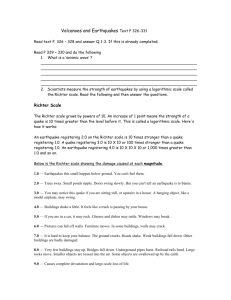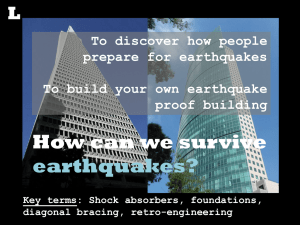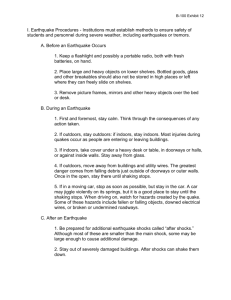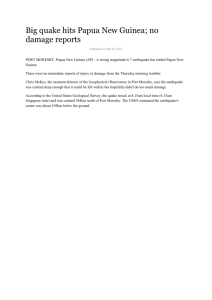Earthquake-Proofing (MS doc)
advertisement
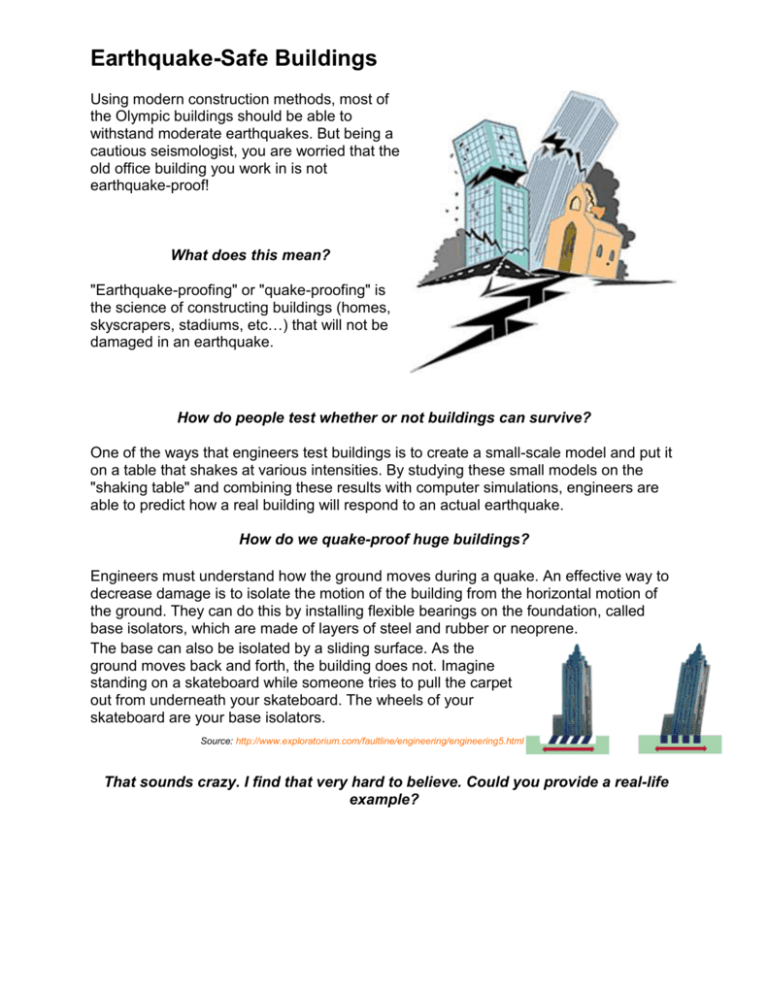
Earthquake-Safe Buildings Using modern construction methods, most of the Olympic buildings should be able to withstand moderate earthquakes. But being a cautious seismologist, you are worried that the old office building you work in is not earthquake-proof! What does this mean? "Earthquake-proofing" or "quake-proofing" is the science of constructing buildings (homes, skyscrapers, stadiums, etc…) that will not be damaged in an earthquake. How do people test whether or not buildings can survive? One of the ways that engineers test buildings is to create a small-scale model and put it on a table that shakes at various intensities. By studying these small models on the "shaking table" and combining these results with computer simulations, engineers are able to predict how a real building will respond to an actual earthquake. How do we quake-proof huge buildings? Engineers must understand how the ground moves during a quake. An effective way to decrease damage is to isolate the motion of the building from the horizontal motion of the ground. They can do this by installing flexible bearings on the foundation, called base isolators, which are made of layers of steel and rubber or neoprene. The base can also be isolated by a sliding surface. As the ground moves back and forth, the building does not. Imagine standing on a skateboard while someone tries to pull the carpet out from underneath your skateboard. The wheels of your skateboard are your base isolators. Source: http://www.exploratorium.com/faultline/engineering/engineering5.html That sounds crazy. I find that very hard to believe. Could you provide a real-life example? Earthquake-Safe Buildings On October 17, 1989, a magnitude 7.1 earthquake struck the mountains in central California. Sixty miles away, in downtown San Francisco, the occupants of the Transamerica Pyramid were very very nervous as the 49-story office building shook for more than one minute! Scientific instruments in the building showed that the top floor swayed more than 1 foot from side to side. However, no one was seriously injured, and the Transamerica Pyramid was not damaged. This famous San Francisco landmark had been designed to withstand even greater earthquake stresses, and that design worked as planned during the earthquake! Source: http://quake.wr.usgs.gov/prepare/factsheets/SaferStructures/ What other techniques can we use to quake-proof our buildings? The frame of your seismology office looks exactly like this picture. This is the "skeleton" of your building. As you can see, the frame of your building is made of three "units". The dimensions of each unit are 15m x 10m x 10m. source: http://www.mori.co.jp/english/atago/06.html One of the ways to quake-proof an office building is to install diagonal beams. This is similar to adding extra bones to make your skeleton stronger. Adding diagonal beams to your building causes the frame to look something like this next picture. Of course, you won't be able to rip apart your office building, so you will have to hire a construction crew to install diagonal beams on the sides of your building. The act of quakeproofing an old building is usually called "retrofitting". If the cost of the beams is $1000 per metre, how much will it cost retrofit your seismology office? Earthquake-Safe Buildings Of course, if you knew an earthquake was about to happen, you would have installed the beams when your building was first constructed. The cost of the beams, in this case, is $1900 per metre, but you would only have to use half the total beam length in the previous question. Would this have saved you money? If so, how much? Can you actually feel the building move during an earthquake? It depends on the magnitude of the quake. Believe it or not, a well-built structure is actually designed to sway during an earthquake! A flexible building is able to absorb force and will not break as easily. As we've seen, in the Transamerica Pyramid, which is a 49-story building, the top floor swayed more than 1 foot from side-to-side! What if you were standing on the roof of your office building when the quake hits? Because you work in a very old building it doesn't have any base isolators. If the quake hits, your building will sway from side to side. Lets calculate how much you might move. Pretend you are standing in the middle of the roof. The quake might cause your building to move 5° off-centre. Therefore, the angle that the base of your building makes with the ground is 85°. All of a sudden the perimeter of your building has changed from a rectangle to a parallelogram! What distance have you moved horizontally? Remember to use all the information you've been given so far. Did you sway further than the top of the Transamerica Pyramid in San Francisco? What should I do to help protect myself from earthquakes? Let's find out.


